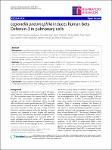Legionella pneumophila induces human beta Defensin-3 in pulmonary cells
Scharf, Stefanie
Vardarova, Kremena
Lang, Friederike
Schmeck, Bernd
Opitz, Bastian
Flieger, Antje
Heuner, Klaus
Hippenstiel, Stefan
Suttorp, Norbert
N'Guessan, Philippe D
Background: Legionella pneumophila is an important causative agent of severe pneumonia in humans. Human alveolar epithelium and macrophages are effective barriers for inhaled microorganisms and actively participate in the initiation of innate host defense. The beta defensin-3 (hBD-3), an antimicrobial peptide is an important component of the innate immune response of the human lung. Therefore we hypothesize that hBD-3 might be important for immune defense towards L. pneumophila. Methods: We investigated the effects of L. pneumophila and different TLR agonists on pulmonary cells in regard to hBD-3 expression by ELISA. Furthermore, siRNA-mediated inhibition of TLRs as well as chemical inhibition of potential downstream signaling molecules was used for functional analysis. Results: L. pneumophila induced release of hBD-3 in pulmonary epithelium and alveolar macrophages. A similar response was observed when epithelial cells were treated with different TLR agonists. Inhibition of TLR2, TLR5, and TLR9 expression led to a decreased hBD-3 expression. Furthermore expression of hBD-3 was mediated through a JNK dependent activation of AP-1 (c-Jun) but appeared to be independent of NF-κB. Additionally, we demonstrate that hBD-3 elicited a strong antimicrobial effect on L. pneumophila replication. Conclusions: Taken together, human pulmonary cells produce hBD-3 upon L. pneumophila infection via a TLR-JNK-AP- 1-dependent pathway which may contribute to an efficient innate immune defense.
Dateien zu dieser Publikation
Keine Lizenzangabe
Verwandte Publikationen
Anzeige der Publikationen mit ähnlichem Titel, Autor, Urheber und Thema.
-
2013-03-11ZeitschriftenartikelTowards further reduction and replacement of animal bioassays in prion research by cell and protein misfolding cyclic amplification assays Boerner, Susann; Wagenführ, Katja; Daus, Martin L.; Thomzig, Achim; Beekes, MichaelLaboratory animals have long since been used extensively in bioassays for prions in order to quantify, usually in terms of median infective doses [ID50], how infectious these pathogens are in vivo. The identification of ...
-
2011-09-01ZeitschriftenartikelInfluenza Virus Ribonucleoprotein Complexes Gain Preferential Access to Cellular Export Machinery through Chromatin Targeting Chase, Geoffrey P.; Rameix-Welti, Marie-Anne; Zvirbliene, Aurelija; Zvirblis, Gintautas; Götz, Veronika; Wolff, Thorsten; Naffakh, Nadia; Schwemmle, MartinIn contrast to most RNA viruses, influenza viruses replicate their genome in the nucleus of infected cells. As a result, newly-synthesized vRNA genomes, in the form of viral ribonucleoprotein complexes (vRNPs), must be ...
-
2011-06-28ZeitschriftenartikelMolecular in situ topology of Aczonin/Piccolo and associated proteins at the mammalian neurotransmitter release site Limbach, Christoph; Laue, Michael; Wang, Xiaolu; Hu, Bin; Thiede, Nadine; Hultqvist, Greta; Kilimann, Manfred W.The protein machinery of neurotransmitter exocytosis requires efficient orchestration in space and time, for speed and precision of neurotransmission and also for synaptic ontogeny and plasticity. However, its spatial ...

